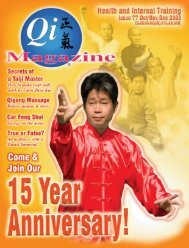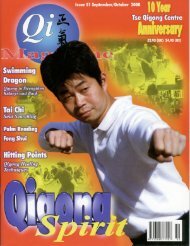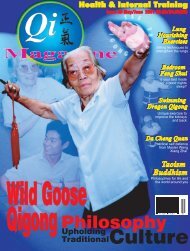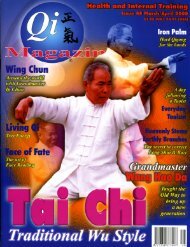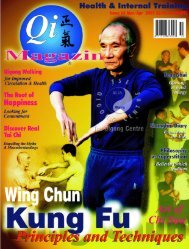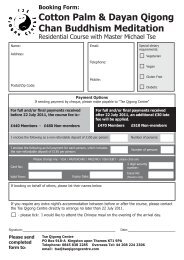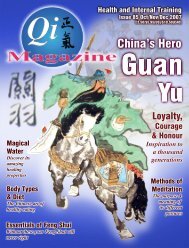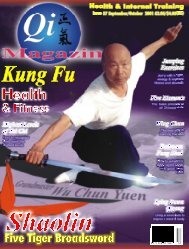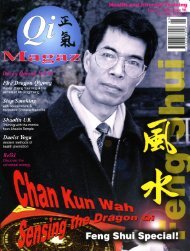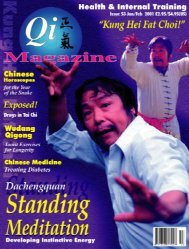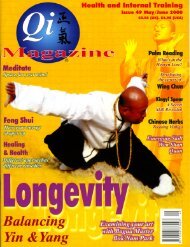Create successful ePaper yourself
Turn your PDF publications into a flip-book with our unique Google optimized e-Paper software.
myofascia, relaxing over-tense or spasming muscles, releasing<br />
stagnated lymph and enhancing capillary blood flow. Initially<br />
techniques are used that spread the force over a large area. This<br />
avoids deeply penetrative pressure before the “softening up”<br />
process has been completed. Palm pressing, and<br />
kneading, and whole-hand squeezing are<br />
most frequently used at this stage. As the<br />
tissues respond, these more gentle<br />
techniques give way to ones that focus the<br />
massaging force to produce more deeply<br />
penetrating pressure. The unique rolling<br />
method, which uses the knuckles and<br />
dorsum of the hand like a rolling pin, is<br />
brought into action to complete this<br />
preparation of the soft tissues for the<br />
treatments that are to follow.<br />
2. STIMULATING QI FLOW IN THE<br />
MERIDIANS.<br />
The courses of the meridians are now<br />
subjected to a wide variety of squeezing;<br />
kneading and rolling applied with much<br />
more vigour. Fingers, thumbs, heels of<br />
palms, forearms and even elbows are the<br />
therapist’s tools. In all the techniques,<br />
pressure is accompanied by movement from<br />
a vast spectrum, be it vibratory, rotational,<br />
rocking or percussive, to large scale pushing<br />
and rubbing. Unlike Shiatsu or Thai<br />
traditional massage, practitioners who use<br />
a very steady and unhurried approach, their<br />
Tui Na counterparts constantly change<br />
tempo. Two handed chaffing, for example,<br />
is done at lightning speed; rolling is effective at up to 140 rolls<br />
per minute, while much kneading and plucking is very slow to<br />
facilitate sustained pressure.<br />
3. STIMULATING THE ACU-POINTS.<br />
Thumbs and elbows are the most frequently used tools<br />
for focusing pressure into the acupoints. This should only be<br />
done when the soft tissues have become softened and relaxed<br />
to encourage Qi flow. Accuracy is essential and short thumb<br />
nails a must. Pressure is applied to the acupoints with movement<br />
usually of a rotary or rocking kneading action. Very tender or<br />
painful acupoints can indicate a Qi blockage and for these,<br />
penetration must be progressive. It may take several treatments<br />
before penetration can reach the ideal depth for complete release<br />
of Qi blockages. Most people adapt very quickly to this deep<br />
and vigorous treatment. Some even become quite addicted to<br />
it! It should be emphasised, however, that a successful treatment<br />
depends more on the<br />
combination of acupoints used,<br />
than on the depth of<br />
penetration into them. Expert<br />
knowledge is required before<br />
the right choices of acupoints<br />
can be made with certainty.<br />
Many of the acupoints that<br />
figure prominently in Tui Na<br />
treatments are well known to<br />
Qi Gong practitioners because<br />
of their ability to boost Qi levels and the immune system. Large<br />
Intestine 4, Stomach 36, Bladder 23 and Ren 6 are good examples.<br />
Points such as Pericardium 8 (Laogong) and Yintang are used in<br />
Tui Na and <strong>Qigong</strong> to clear and calm the mind.<br />
4. MANIPULATIONS.<br />
These are left until all the soft tissue<br />
work and acupressure have been<br />
completed. So important is the attainment<br />
of a good degree of muscle and myofacial<br />
release to render the soft<br />
tissues permeable to Qi<br />
that the first three stages<br />
of a treatment will<br />
require at least threequarters<br />
of the time<br />
devoted to the massage.<br />
Manipulations done on<br />
body parts that are tense,<br />
fibrotic and cold are not usually very<br />
effective. Some Tui Na manipulations<br />
have an apparent simplicity that<br />
totally belies their effectiveness. The<br />
extended arm and leg shakes are<br />
good examples. The success of some<br />
depends on the simultaneous<br />
pressing of specific acupoints.<br />
Many involve relatively small<br />
scale, subtle movements others<br />
are very vigorous with very big<br />
movements across joints.<br />
Whatever their scale, most<br />
manipulations are designed<br />
to capitalise on increased<br />
Qi flow and balance<br />
to improve mobility.<br />
The author,<br />
after spending<br />
countless hours in<br />
TCM hospitals in<br />
China, is still<br />
amazed at the<br />
seemingly endless<br />
variety and<br />
subtle nuances of<br />
approach that<br />
characterise<br />
Tui Na manipulations,<br />
some of which are illustrated here.<br />
THE FUTURE FOR TUI NA.<br />
In China, even hospitals of Western medicine have<br />
departments of Tui Na and acupuncture. The author strongly<br />
supports the view of a rapidly growing group of people who<br />
have experienced its benefits that this should become normal<br />
practise in the West. Both Tui Na and acupuncture can stand<br />
alone as powerful healing systems for most chronic and many<br />
acute conditions. Together they compliment one another to<br />
perfection and gel into a system of therapy that has no equal<br />
byMariaMercati.<br />
Photo’sfromMaria’sbook‘TuiNa -MassagetoAwakenBody&Mind.Courtesy<br />
ofGaiaBooks. Mariacanbecontactedon:01242582168<br />
Qi Magazine 21



